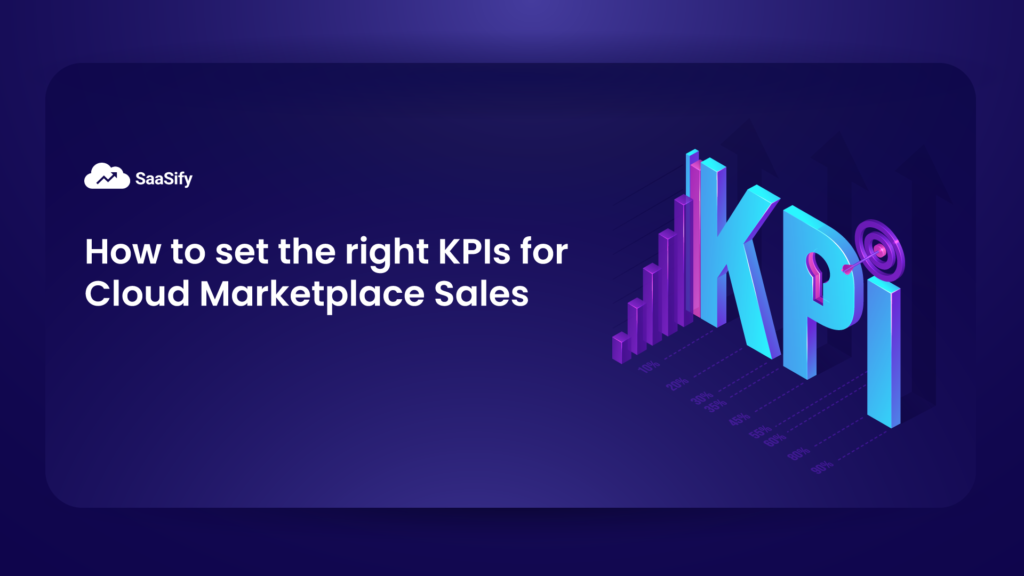As an ISV, if you are contemplating moving to the cloud marketplace, you must spend some effort and energy to understand how you will measure your success in this new sales channel. Like any other means of selling, you need to track and measure your success in the cloud marketplace by leveraging Key Performance Indicators or KPIs. In the absence of KPIs for cloud marketplace, you will be unable to measure the degree of success and effectiveness of selling in the cloud and will have a hard time gauging the efficacy of your strategy.
Furthermore, working with 100s of ISVs through the course of our journey at SaaSify, we have realized that when you set up the right KPIs for cloud marketplace, the teams have a clear sense of what they are working towards, and there is a strategic move towards a collective vision. Therefore, you need to pick the right KPIs, rather than simply replicating the ones you use for your conventional sales channels. If you rely on your conventional KPIs, chances are you will end up measuring the wrong indicators, leading to a skewed image of the performance and level of success. If you go about this process strategically, you can pick the right indicators to facilitate your geographical and revenue growth.
Through the course of this article, we will focus on the journey to set the right KPIs seamlessly and shed light on the top KPIs for cloud marketplace which can help spell success for your ISV business.
What are KPIs?
Key Performance Indicators or KPIs are metrics that organizations leverage to measure their performance over time towards a specific objective. It can help you gauge how well you have been able to achieve your goals as an ISV. When it comes to the cloud marketplace, KPIs can help you understand how well you are able to realize your objectives that motivated the move. They seek to provide a strategic direction to your team members and help focus on key priorities, rather than diluting the focus. Using the right KPIs can help you adopt a more efficient and effective approach towards goal achievement and lead to better business outcomes.
How to set the right KPIs for cloud marketplace
Let’s start the discussion by understanding how you can set the right KPIs for cloud marketplace journey.
Set ambitious but realistic goals
Your KPIs seek to measure your goals to help you gauge whether you have been able to achieve them or not. Therefore, before you set your KPIs, be clear on your goals from the cloud marketplace. These goals will serve insights into what your KPIs for cloud marketplace should look like. For instance, if your goal of selling in the cloud marketplace is to engage your existing customers and capitalize on their committed spends, your KPI should measure their level of stickiness, deal size, sales cycle, etc.
Here, you need to be sure that your goals are ambitious but not unrealistic because if they become unrealistic, your KPIs for cloud marketplace will never show an upward progress, leading to a lack of motivation in the team.
Align KPIs with your goals
Taking cue from the first point, make sure your KPIs for cloud marketplace are aligned with your goals. If you fail to do so, the purpose of setting either is defeated. The logic is simple, your KPIs intend to help you measure your degree of success which is defined by your goals. If there is a lack of alignment between the two, you will end up measuring indicators that have nothing to do with your cloud marketplace success.
Set multiple KPIs
Next, it is important to remember that you cannot set KPIs only in one aspect of your cloud marketplace business, without focusing on the others. You need to interlink all your KPIs for cloud marketplace and facilitate holistic growth. In fact, you might even need several KPIs for a single goal which corresponds to its different aspects. For instance, if your goal is to increase revenue, you need to have multiple KPIs around new customer acquisition, recurring revenue, size of deals, etc. The idea is to ensure that all aspects of your goal are taken care of. Furthermore, it is important to keep a track of KPIs for cloud marketplace like customer experience, stickiness etc.
Set an action plan
Finally, simply setting KPIs for cloud marketplace will not be enough. You need to back it up with an action plan for impact. If you want your team to perform well on the indicator of acquiring new customers, you need to provide adequate marketing and sales support to achieve the same. Therefore, you need to view KPIs for cloud marketplace with a strategic lens where they bring together goals, objectives and a way forward towards success i.e. how you seek to achieve the KPI in question.
Start your journey as a new marketplace seller with these 4 KPIs
Now that you have a clear understanding of how to set KPIs for your SaaS product on the cloud marketplace, let’s explore the top 4 KPIs for cloud marketplace that most ISVs are leveraging for success.
1. Shorter sales cycle
When compared to conventional channels, cloud marketplaces tend to have shorter sales cycles. The major reason behind this is that your customers are likely to already have committed spends on the cloud with Microsoft Azure Consumption Commitment, etc. Therefore, the approval cycle for budget for your SaaS solution becomes significantly shorter. In conventional channels, the budget might be moved to the next quarter, leading to delayed acquisition of revenue. However, when you have to capitalize on the pre-committed spends, this delay can be avoided.
Therefore, one of the top KPIs for cloud marketplace that you should be measuring is whether or not you have been able to close your deals faster. If yes, by what percentage or degree. Clearly, if you are able to close your deals faster or have a shorter sales cycle, your resource utilization for each deal will go down, enabling you to close more deals. Thus, you need to measure the duration of each sales cycle to understand whether or not your move to the cloud marketplace makes business sense. Ideally, it will.
2. Greater value or size of the deals
The next KPI for the cloud marketplace that can help you determine the success for selling your SaaS product is the size or the average value of the deal. Generally, customers who transact through the cloud marketplace have pre-committed spends that they seek to utilize and are more open to larger or deals with greater value. However, in the legacy or direct sales channels, since there is no pre-committed budget, size of the deal is usually on the conservative side.
Therefore, your next KPI should focus on the average size or value of deals secured through the cloud marketplaces versus the ones through direct sales. Furthermore, depending on the unutilized pre-committed spends, you might also be able to secure multi-year contracts, which are unusual for direct sales channels. You can take advantage of the dedicated cloud spend or budget to expand contract size and term at the time of renewal. Measure the overall value derived through your deals in the cloud marketplace and if it is higher than your conventional channels, you are on the right track.
3. Reduced operational overheads
In the conventional sales channels, there are several operational and vendor management overheads that you have to navigate to have a deal in place. Each enterprise you might be dealing with is likely to have its own due diligence and agreement process. However, if you are selling in the cloud marketplaces, you can leverage the standardized agreements, often called the AWS or Azure Enterprise Agreement available, as well as the entire due diligence process becomes a little simpler. For instance, you are able to eliminate the human resources or legal overheads, as most of these will be taken care of by the cloud marketplace you are transacting in.
Thus, one of the top KPIs for cloud marketplace here is to gauge how well you are able to reduce the operational overheads, both in terms of financial resources and costs as well as time commitment and human resource utilization. Invariably, the cost and time you save from these non-value add tasks can be invested in new customer acquisition, to boost up sales or to improve customer experience.
4. Improved net promoter score
Net promoter score is a metric that most ISVs leverage to gauge their customer experience. It basically involves measuring how likely your customers are to recommend your SaaS solution to those in their network based on their experience. When your customer transact through the cloud marketplace, there is a significantly reduced friction and operational overheads on their side as well. They don’t have to repetitively have to go through approvals and due diligence, which contributes to a positive experience. Furthermore, they are able to capitalize on their committed spends, which makes financial sense for them.
Therefore, the next KPI you should measure is your net promoter score to see whether or not it has improved as compared to the conventional sales channels. This KPI can help you measure your performance on your goals around customer satisfaction and stickiness.
Score high on your KPIs for cloud marketplace with SaaSify
Once you have decided on the top KPIs you wish to measure, you need to take the leap and start your journey in the cloud marketplace. To ensure that you score high on your KPIs, you need to eliminate long waiting periods before your SaaS solution actually reaches the cloud marketplace. Here, partnering with SaaSify can do the trick. You can publish your solution on the top cloud marketplaces within a week with SaaSify’s zero engineering platform. Enjoy an effortless marketplace selling experience and maximize your business growth, where scoring high on your KPIs for cloud marketplace is a natural result. Book a demo today!
The blog was originally published on SaaSify.




















